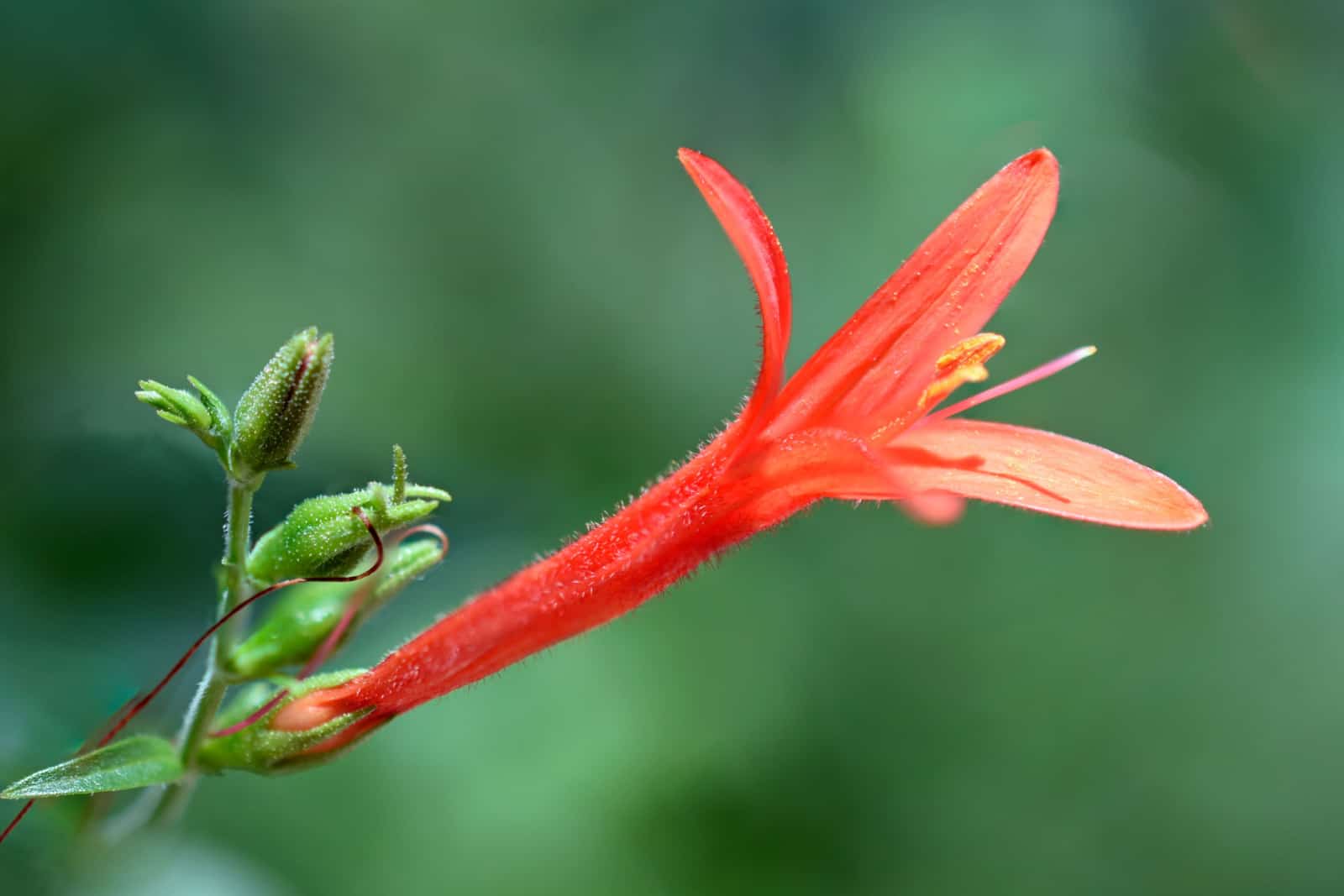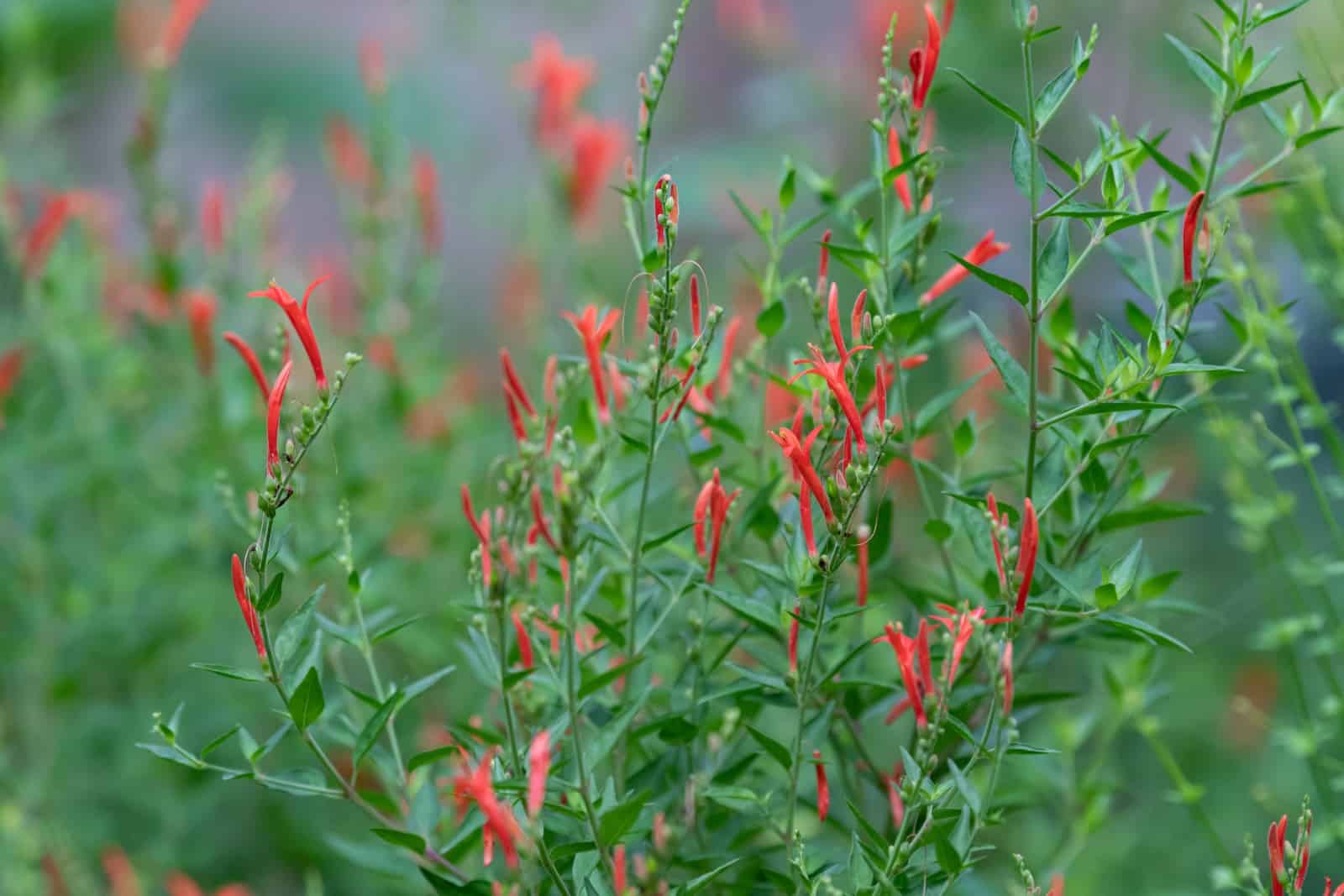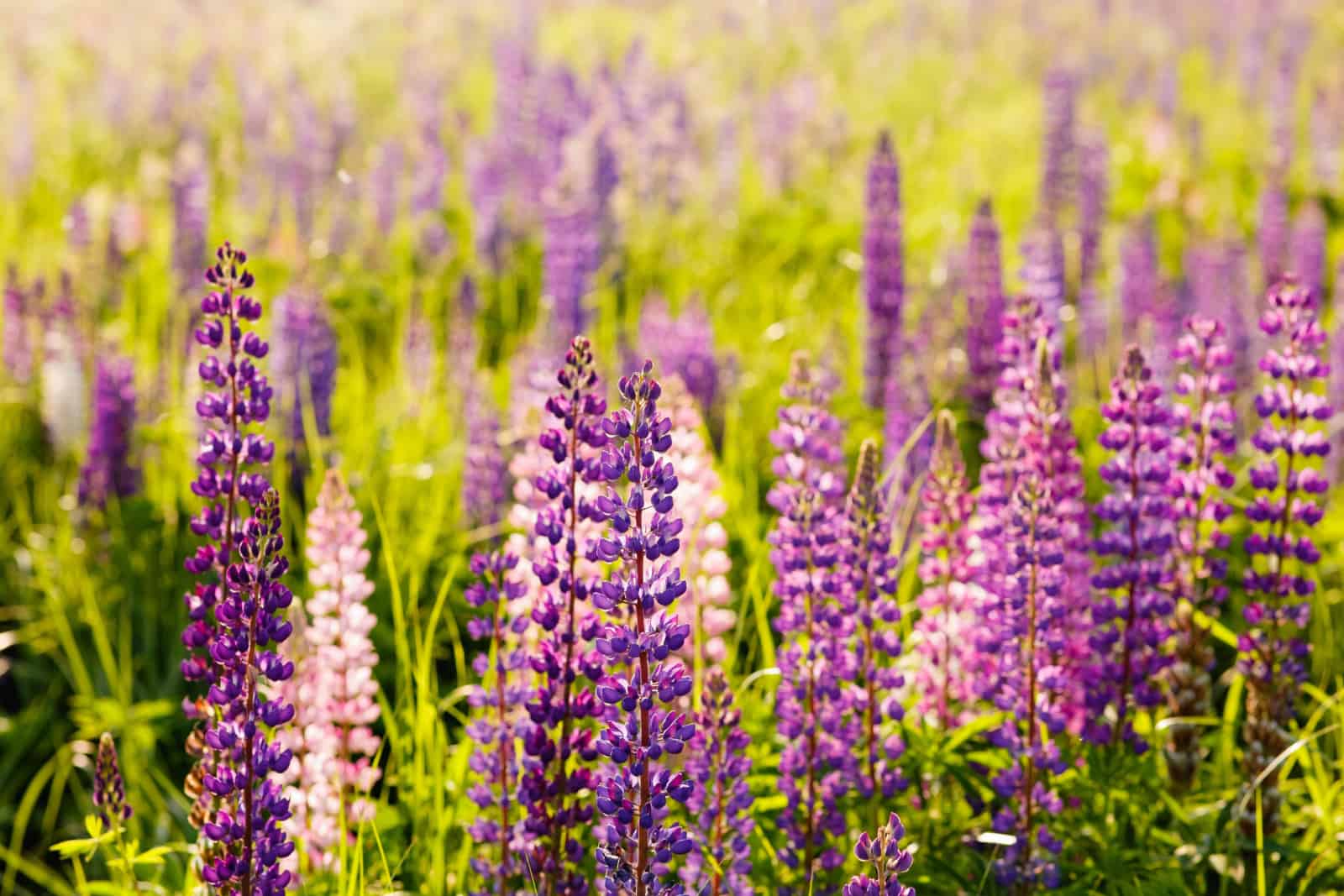The hummingbird bush is a fantastic Texas-native plant known for its bright orange-red flowers that resemble flames, hence its common name, the flame acanthus.
And as well as looking fabulous and attracting pollinators, this plant is also easy to grow because it can thrive in various soil types, tolerates heat and dehydration quite well, and can even be grown in gorgeous planters.
It doesn’t require too much care to thrive, but even with the best intentions, pests and diseases can still afflict it and can cause a lack of flowers. Don’t worry, though, because we’ll tackle all the questions you may have in the following article.
Before we get to all that, let’s find out some more info about this species:
[table id=605 /]
Hummingbird Bush Plant Care
Hummingbirds love hibiscus flowers, the flame acanthus, and many other plants with tubular flowers and a lot of nectar.
These species look amazing in flower beds, but we’re here to discuss the best growing conditions for the hummingbird bush.
This plant requires full sun, but can tolerate partial shade, well-drained soil, and occasional watering.
And if you want to take your gardening skills to another level, you can find the best propagation, repotting, pruning, and fertilizing tips below.
Light Requirements
The flame acanthus thrives in full sun to partial sun. It prefers at least six hours of direct sunlight a day, although it can tolerate some afternoon shade in hot climates.
It can tolerate heat quite well, but in areas with scorching summers, it may benefit from a bit more shade to prevent the leaves from getting scorched.
Water And Humidity
In the first year after planting, it is essential to water this plant regularly to help it establish a strong root system. Afterwards, it can survive on natural rainfall alone, although it may require occasional watering during periods of drought.
Generally speaking, it is best to allow the soil to dry out slightly between waterings.
Furthermore, the worst time to water your plants is in the afternoon when moisture quickly evaporates, or at night when it simply sits in the soil and creates a perfect environment for fungi.
Instead, whenever you notice that this hummingbird magnet requires supplemental watering, irrigate it in the morning or late afternoon.
Finally, the flame acanthus is a drought-tolerant plant that doesn’t require a lot of moisture to thrive. It has deep roots that allow it to access water and survive during dry periods (although it will produce more blossoms if you water it from time to time).
Humidity
The hummingbird bush is native to Texas and parts of Mexico, and as such, it has adapted to hot and dry conditions.
It tolerates dry air well, and you won’t have to worry about increasing humidity. Water it if it seems a bit dry and drooping, and that’s it!
Temperature
The flame acanthus prefers temperatures ranging from 70-80°F during the day and 60-70°F at night.
It can tolerate temperatures as low as 10°F and as high as 110°F for short periods, making it a good choice for hummingbird gardens in regions with extreme temperatures.
Soil And Fertilizer
This plant can survive in various soil types, as long as they’re well-draining and rich in organic matter. It tolerates multiple substrate textures, from sandy to loam to clay, and it can thrive in mediums with a pH level between 6.1-7.8.
It is a good idea to mix in some compost or other organic matter to improve the soil structure and provide nutrients for the plant.
And lastly, the hummingbird bush doesn’t require additional fertilization, especially if you grow it in nutrient-rich soil.
Propagation
There are many different plant propagation methods out there, but we cannot apply all of them to the hummingbird bush. Luckily, we can multiply this plant through seeds or stem cuttings.
(The flame acanthus produces seeds in late fall after the flowers have been pollinated, and if you don’t want the plant to spread on its own, you should remove them).
Propagating this shrub from stems is easiest, and all you need to do is take healthy cuttings with a lot of foliage.
Remove the bottom leaves (only leaving the top ones), dip the end in rooting hormone, and plant the cutting in a seed-starting mix. Water it thoroughly, create a humid environment around it, and keep it in bright light to speed up rooting.
Repotting
This bush is an avid grower, so you should repot it once it doubles in size. Find a container one or two sizes larger than the previous one, put some growing medium in the bottom, plant the flame acanthus, and cover the roots with more soil.
Water the plant thoroughly and keep it in a sunny location.
Pro tip: Every plant goes through transplant shock after being moved, but you can reduce the effects by repotting this bush on a cloudy day and ensuring it’s hydrated beforehand.
Pruning
The best time to prune the hummingbird bush is in late winter or early spring, just before the plant starts putting on new growth.
Remove all the dead branches, and wait for new ones to appear.
You should also remove any dry, dead, or diseased foliage all year round to keep your plant healthy.
Benefits Of The Hummingbird Bush
Now that we know how to care for this low-maintenance plant, let’s learn more about its benefits. The hummingbird bush is tolerant of extreme conditions, attracts pollinators, and produces lots of flowers, making it desirable for many gardens.
It has even more benefits than that, and you can learn about them all below!
Heat And Drought-Tolerant
The hummingbird bush is a xeriscape plant, which means it can survive in inhospitable and dry climates. It tolerates extreme temperatures, doesn’t mind the heat, and can survive dry spells.
Of course, if you want it to adorn your landscape with many blossoms, you shouldn’t expose it to the extremes; water it occasionally and protect it from the scorching midday sun.
Attracts Pollinators
One of the many benefits of the flame acanthus is its ability to attract hummingbirds, butterflies, and other pollinators to your garden all year round.
Of course, you can also install feeders to create a hummingbird garden, but natural nectar is always better.
Pest And Disease-Resistant
The flame acanthus is deer-resistant and pests and diseases don’t usually afflict it. Of course, it can get overwatered and suffer from root rot, but so can any plant, which is why you should only water it when the top few inches of the soil are dry.
And if your garden gets infested during its bloom time, try implementing pest control methods during flowering, which will keep those blossoms safe. You can use natural pesticides, horticultural oils, garlic, tobacco, or oil sprays, etc.
Tolerates Various Soils
This flowering shrub can thrive in sandy, clay, and loam substrates as long as they’re well-drained and nutrient-rich.
This ability makes it perfect for all gardens; simply amend your garden soil with some compost, and the flame acanthus will thrive.
Produces Many Flowers
It is quite challenging to find plants that can flower abundantly in hot and dry climates, and the hummingbird bush checks this box as well.
The flame acanthus blooms from mid-to-late summer until the freezing temperatures stop it. And if you want to enjoy the orange-red trumpet flowers, you should grow this plant in full sun and water it from time to time during drought.
Container-Friendly
You can grow this shrub in a planter if you can’t find a perfect spot in your garden. Plant it in a large container with drainage holes, and place it near your other annual and perennial flowers in your pollinator garden.
Other Popular Hummingbird Plants (Lupine, Salvia)
There are many plants on the list of flowers that attract hummingbirds and butterflies, such as lupine, salvia, honeysuckle, trumpet vine, etc.
These perennial flowers go pretty well with bushes and shrubs such as hibiscus and hummingbird bushes, and complement each other nicely.
There are also varieties under the name “hummingbird bush” that belong to different genera, such as Dicliptera suberecta, Grevillea thelemanniana, and Hamelia patens. However, these plants are non-natives, so you should be careful when growing them as they can become invasive.
Final Thoughts
The hummingbird bush is a low-maintenance plant that flourishes in full sun conditions (or partial shade if you live in scorching climates) and well-draining soils. It is drought-tolerant, so you only need to water it during the dry periods.
You don’t need to fertilize the flame acanthus; you can propagate it through seeds or stem cuttings, and you should prune it in late winter or early spring before it spurts out new growth.
We also included some of the benefits of having this shrub in your garden: it is highly tolerant of extreme conditions, resistant to pests and diseases, attracts pollinators, blooms heavily, and you can grow it in the ground or in a container.
Enjoy this amazing plant, and until next time!




